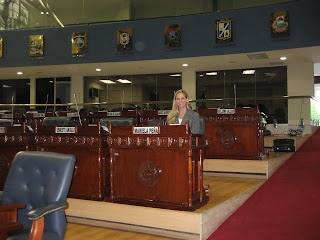Capital: San Salvador
Population: 7 million (approximately 2 million El Salvadorans are currently living abroad)
Official Language: Spanish
Currency: U.S. Dollar (since 2001)
Government Type: Republic
President: Elias Antonio (Tony) Saca
Primary Religion: Roman Catholic
Literacy rate: 83 percent male, 78 percent female
Education: 30 percent of high school age students attend school, 90 percent of grade 1-9 students attend school, but quality is admittedly poor
Economic: most stable economy and lowest inflation rate in Central America
El Salvador is geographically the smallest country in Central America and is the most densely populated and most industrialized.
Approximately 90 percent of urban residents have access to potable water, compared to 80 percent in rural areas.
Approximately 98 percent of urban residents have direct connect access to electricity, compared to 50 percent in rural areas.
Downtown San Salvador. These photos are taken out the window on a bus tour, we did not have the opportunity to get out and explore.


Marketplace downtown San Salvador.


Transportation in downtown, in addition, there are 5,000 buses that run routes in San Salvador.





















































